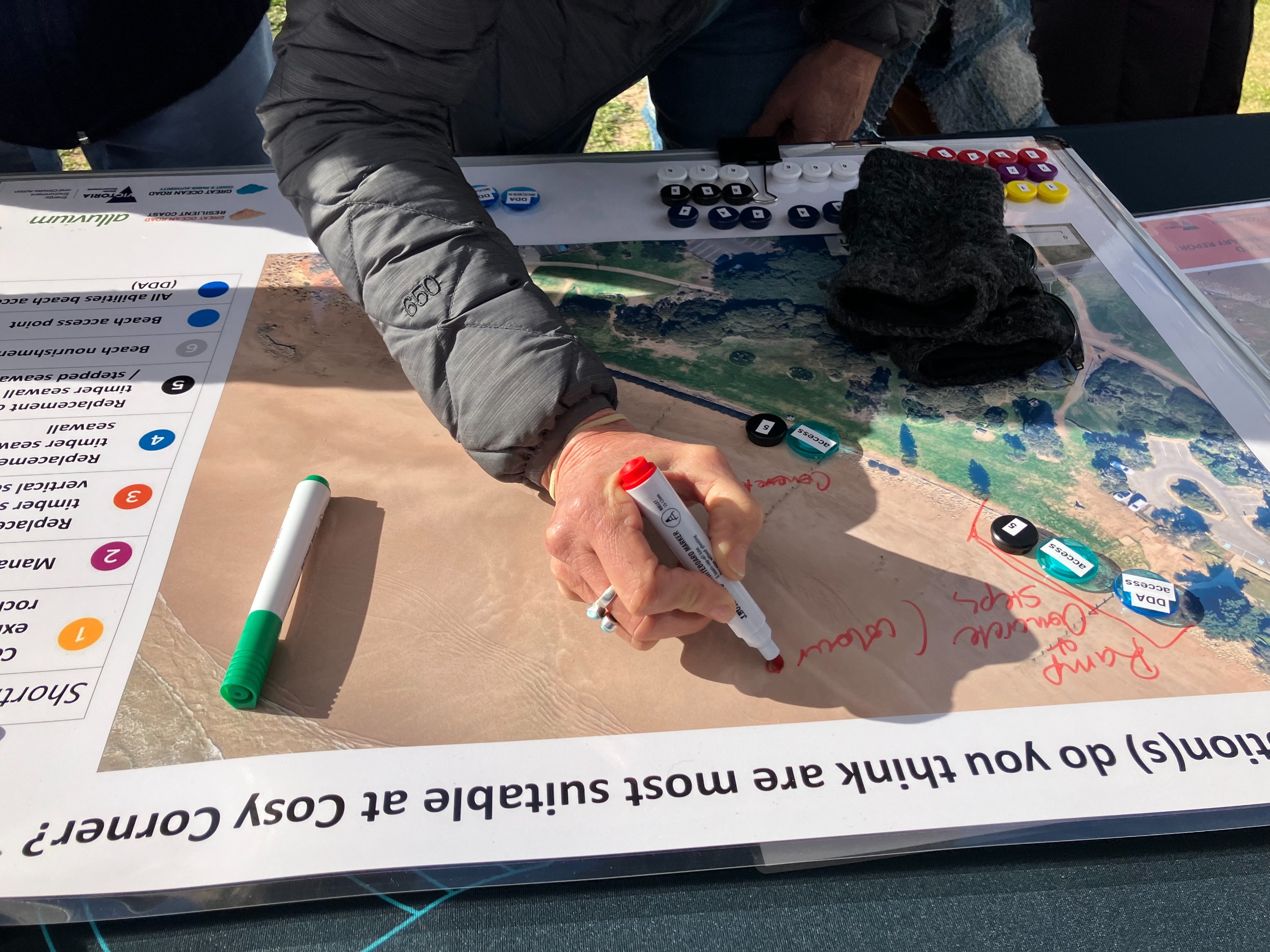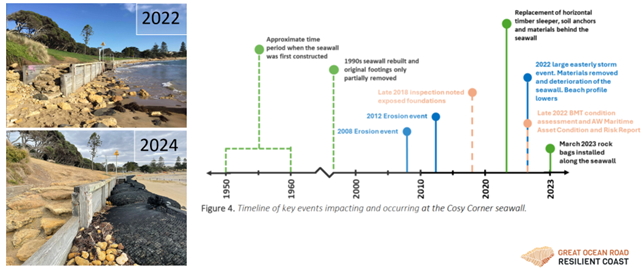We are currently at Stage 5 - Adaptation Actions and Pathways
Project Update: We have received funding through Round 3 of the Federal Government's Disaster Ready Fund to bolster the region's resilience to coastal hazards, ensuring the protection and sustainability of the region’s cultural, environmental, economic, and social assets, including critical infrastructure works. This includes the seawall upgrade at Cosy Corner.
We are currently part way through Stage 5 of the coastal adaptation planning process with works to commence on the seawall upgrade in late 2026 or early 2027.
We have to date considered potential adaptation options and their suitability for Cosy Corner, informed by community engagement at Stage 5, and have a concept design for the preferred option of a vertical seawall. We are currently awaiting results from our geotechnical assessments of the site before progressing from concept to detailed design and further community engagement.
Photo below: Stage 5 community engagement onsite at Cosy Corner capturing community input into seawall upgrade.

Cosy Corner Timber Seawall Upgrade
The much-loved timber seawall at Cosy Corner, built in the 1950’s and rebuilt or repaired several times, has deteriorated beyond repair. A row of rock bags were placed at the toe of the structure in March 2023 to reduce further undermining whilst adaptation planning and design work was undertaken to determine how to best upgraded the seawall.

In 2024 we commenced working to develop an adaptation plan and design for the timber seawall at Cosy Corner in Torquay and want to engage with beach users, community members and other key stakeholders to help inform the seawall upgrade.
The aim of the timber seawall adaptation plan is to increase Cosy Corner's resilience and better protect it against coastal hazards, set to increase in magnitude and frequency due to climate change and sea level rise.
We have previously detailed information about this project as a part of a longer webinar. Watch the webinar recording here. This project features at the 30 minute and 50 second mark.
The Great Ocean Road Coast and Parks Authority are taking a partnership approach to plan for and manage coastal hazards along our beloved coastline, now and into the future.
Our approach is following the direction of the Marine and Coastal Policy 2020 and Victoria’s Resilient Coast – Adapting for 2100+ framework and guidelines.
Currently will be entering in to Stage 5 of the planning process from the 26th of June.
We are engaging with community at every stage of the process because whilst there are many steps involved in coastal adaptation planning, it is the community values and local knowledge that help to provide a foundation for confirming coastal values and objectives, and ultimately tailoring adaptation options.

Stage 1 - Project Scoping and Preparation
Work on Stage 1 was completed earlier this year and provides a foundation for commencing/progressing coastal hazard risk management and adaptation planning, aligned to best practice guidance, for the Anglesea coast.
A key deliverable for Stage 1 was the Project Plan for Anglesea Coast Adaptation Planning. The plan is supported by all project partners and outlines the following:
• the need for action – refined through the collaborative work of the scoping stage
• the project study area
• the project governance model
• the proposed collaborative process for the project, including a Communication and Engagement Plan
• the scope the work required for each Stage
• supporting documentation (e.g. MoU arrangements, funding agreements, other).
Stage 2 - Values, Vision and Objectives
Work on Stage 2 of this project was completed this April and May to ensure coastal hazard risk management and adaptation planning at Cosy Corner was underpinned by place-based values and a shared vision and objectives.
Our engagement for this project was titled Cosy Up and featured an online have your say page and survey, on-site activities such as 'walk and talks' and information sessions as well as large site signage.
We thank the 94 community members who completed the online survey, and the 24 people who provided their insights via one of the ‘walk and talk’ sessions we held at Cosy Corner at Stage 2 of this project.
A key output at this stage was our Stage 2 Summary Engagement Report which captures key themes from what we heard from community at this stage.
The report reflects community values, aspiration and concerns which will help shape our adaptation planning at Cosy Corner and ensure it reflects local values and knowledge.
Stage 3 - Coastal Hazard Exposure
Stage 3 was completed in the first half of 2024 when we assess coastal hazard exposure for the study area, including hazard data / scenarios that enable best practice approaches to risk assessment and adaptation planning.
Work done at Stage 3 provide this project with a better understanding of the study area and geomorphic setting, coastal processes including history of coastal change and drivers of change and different hazard scenarios and their impact at Cosy Corner.
Stage 3 also produced a technical coastal hazard assessment report and hazard exposure data/maps to inform future Stages of this project.
Stage 4 - Vulnerability and Risk
Work recently completed at Stage 4 of this project provided us with a greater understanding of place-based coastal hazard vulnerability and risk for Cosy Corner which enables a strategic approach to considering coastal hazard risk and adaptation needs.
For context coastal vulnerability is defined as the susceptibility of people and places along the coast to adverse impacts from coastal hazards. It includes the degree of exposure, and ability to cope with, respond to and adapt to coastal hazards.
Likewise, the term risk assessment is defined as a systematic process of evaluating the potential risks (likelihood and consequence) of coastal hazards, helping to inform a risk management response and adaptation actions.
The outputs of the coastal hazard vulnerability risk and economic assessments at this such support our work in:
• developing an overall narrative of coastal hazard vulnerabilities.
• summarising the coastal hazard risk assessment results, highlighting high risk areas and issues, and the changing risk profile to 2100.
• identifying where broader strategic actions may apply across multiple areas to address vulnerabilities and risk
• identifying focus areas/issues for finer scale risk management and adaptation planning, including localities for tailored adaptation pathways







